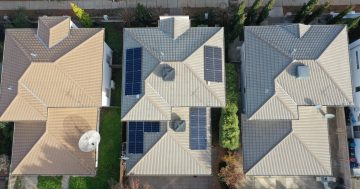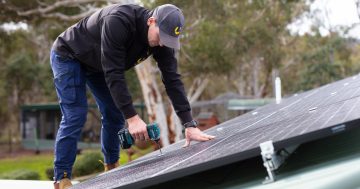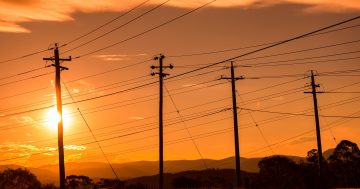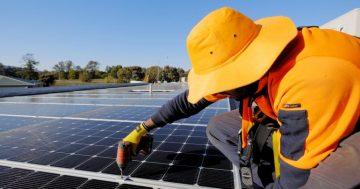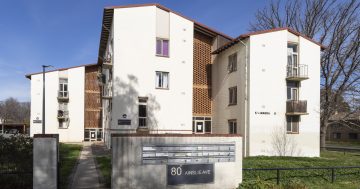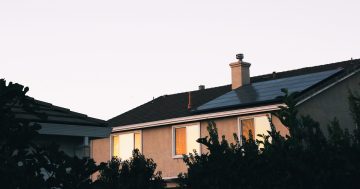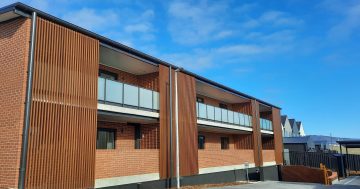
The Chapman public housing development and roofspace going to waste. Photo: Ian Bushnell.
New public housing properties may offer six-star energy efficiency and split-system air conditioners but rooftop solar that might allow tenants to use them without fear of bill shock is not part of the package.
While 100 per cent of the ACT’s electricity will be sourced from renewable sources from January this year and the ACT Government touts its leadership credentials on climate change, the Territory’s most vulnerable tenants may still not be able to afford to heat or cool their properties, despite access to energy rebates and energy-efficient appliances.
The public housing renewal program has seen the building of new low-rise developments, such as the one in Chapman.
Their rooftops seem perfect for photovoltaic systems that would do away with the need for low-income energy rebates and turn the properties into mini powerhouses feeding the grid.
In fact, the idea is canvassed in the ACT Sustainable Energy Policy 2020-25 Discussion Paper. The NSW Solar for Low Income Households Trial allows eligible concession cardholders to forgo their low-income household energy rebates in exchange for free installation of a 2.5 kW solar system.
Climate Change Minister and Greens leader Shane Rattenbury says the ACT Climate Change Strategy 2019-25 includes an action to investigate options for providing solar to public housing and extending the Solar for Low Income Program to those tenants.
At present, Housing ACT does not offer rooftop solar for suitable properties, although tenants can request to install and maintain systems at their own cost, and the Solar for Low Income Program is supporting a limited number of low-income households to do so.
During 2018-19, Housing ACT approved 15 such requests from tenants, who may be required at the discretion of Housing ACT to remove the solar power system and return the property to its original condition when they vacate the premises.
Housing ACT does not collect data on requests to remove systems.
Better Renting executive director Joel Dignam says that wherever practical, it would be great to see rooftop solar on new public housing.
“This would help people in public housing save money on their power bills, and for these people, these savings could make a big difference,” he said. “And more solar energy means less climate pollution from fossil fuels. The ACT Government is already showing leadership by improving the energy efficiency of public housing, and there’s potential to do more here.”
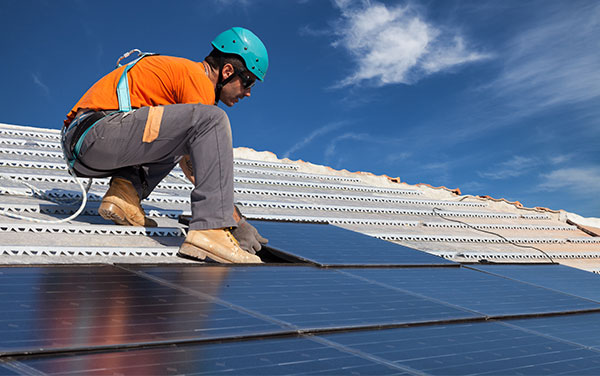
Analysis by St Vincent de Paul Society in its ACT Tariff Tracker Report 2018 found that a Canberra household with solar was around $1000 per year better off compared to a household powered by traditional energy sources.
Mr Dignam said Better Renting backed measures that may support people who rent, or others with unsuitable rooftops, to benefit from solar, including solar gardens, where community members can invest in an off-site solar installation and receive a credit on their electricity bill.
“We hope to see more initiatives like this so that no households are locked out of the benefits of solar,” he said.
At this stage he did not think private landlords should be required to install rooftop solar, although evidence showed it was a great investment for them to make.
“It improves the value of the property, it means your tenants want to stay longer and it reduces the risk of rental arrears. If you think it’s a good idea to invest in a rental property, it’s an even better idea to invest in solar,” he said.
Tenants Union Executive Officer Deb Pippen said rooftop solar would be a good step for Housing ACT to be a model landlord and provide something that ”talks the talk” about caring about energy efficiency and people who are disadvantaged.
But the ACT Council of Social Services is more cautious, saying in its response to the ACT Sustainable Energy Policy 2020-25 Discussion Paper that there were concerns about the NSW trial concept where rebates are foregone and it would want to see a series of case studies that demonstrated the idea’s feasibility and benefits before supporting such a proposal.
The government says Housing ACT manages a portfolio of over 11,700 properties in a mix of housing types, including multi-unit properties, and many may not be suitable for solar panels due to a range of conditions, including the age of the property, orientation and tree coverage.
It says Housing ACT works closely with government and industry stakeholders to provide information to public housing tenants about available rebates, energy savings and how to maximise energy efficiency in their homes. ActewAGL will host an information desk for tenants at the Housing ACT Gateway office in January and February.
Mr Rattenbury says the Greens believe that all Canberrans should have access to comfortable, efficient and affordable housing, and are working to improve the climate resilience and energy efficiency of ACT homes with a focus on rental properties, public housing and low-income households.
“We are committed to supporting the most vulnerable in our community for a just transition to net-zero emissions, where everyone can enjoy the benefits of improved energy efficiency and renewable electricity generation,” he said.












